When you’re cycling through Sarasota’s sun-drenched streets, the last thing on your mind is a potential accident. Yet, understanding liability in bicycle collisions is crucial for your safety and legal protection. Visibility, right of way, and road conditions play pivotal roles in determining fault. As you drive through Sarasota’s bike lanes and busy thoroughfares, factors like inadequate lighting, unclear road markings, or driver inattention can significantly impact liability. Moreover, poorly maintained roads or obstructed bike paths may shift fault to municipal agencies or other parties. Today the law firm of Goldman, Babboni, Fernandez, Murphy & Walsh examines essential factors that influence liability in Sarasota bicycle accidents, empowering you with knowledge to protect your rights on the road.
In bicycle accidents, factors like visibility, right of way, and road conditions often shape the question of liability. Drivers may overlook cyclists due to poor lighting or unclear road markings, while cyclists may be put at risk by drivers who fail to yield or by challenging road conditions. Sarasota’s streets, have their hazards. Inadequate signage, obstructed bike lanes, and poorly maintained roads can heighten the risk of collisions, sometimes shifting responsibility from individual drivers or cyclists to municipal authorities.
Today, the Goldman, Babboni, Fernandez, Murphy & Walsh team explores critical factors that influence fault determination in Sarasota bicycle accidents. Whether you’re a cyclist looking to stay informed or someone who shares the road with bikes, our law firm will guide you with the knowledge to better understand how liability is assessed in these cases, ensuring that you’re prepared and protected if an accident ever occurs.
Visibility Issues in Bicycle Accidents
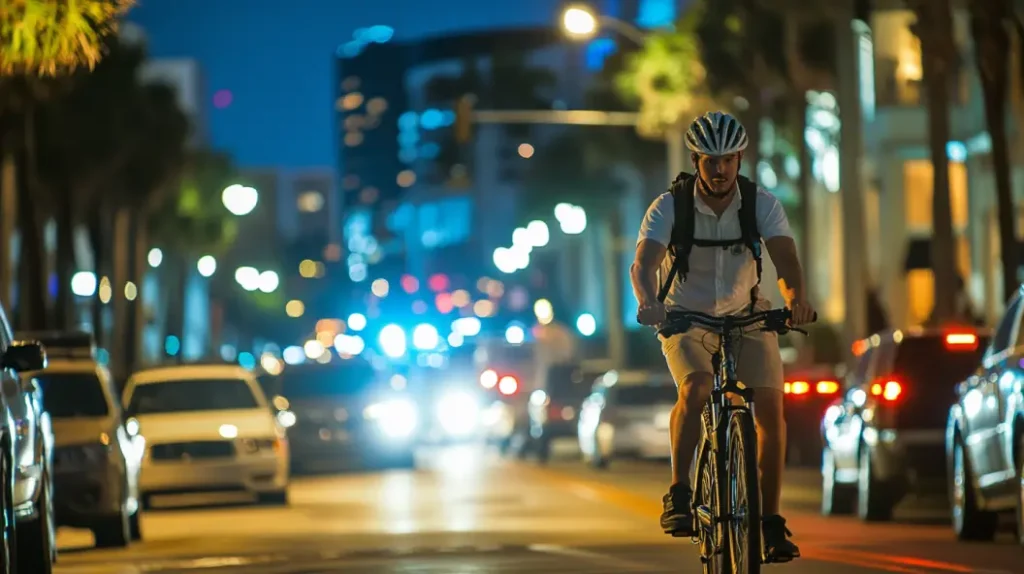
The Perils of Nighttime Cycling
Nighttime cycling presents unique hazards, with reduced visibility being one of the primary factors contributing to increased crash risk for cyclists. When the sun sets, the challenges of spotting cyclists on the road grow exponentially, and even well-intentioned drivers may find it hard to see bikes amidst the low lighting, shadows, and glare from other headlights. This diminished visibility can lead to devastating consequences for those who enjoy or rely on cycling after dark. A Sarasota bicycle accident attorney at Goldman, Babboni, Fernandez, Murphy & Walsh often encounters cases where poor lighting conditions played a part in a bicycle collision.
Cyclists are already less visible on the road due to their smaller profile compared to cars, and this issue becomes more pronounced at night. Even with reflectors and lights, a cyclist’s visibility is often limited to a few dozen feet, leaving drivers with little time to react, particularly on darker streets or poorly lit intersections. As a result, cyclists face an increased risk of not being seen until it’s too late for drivers to respond safely. This issue is especially pressing in Sarasota, where popular cycling routes may be shared with regular vehicle traffic, and street lighting can be inconsistent.
From a legal perspective, the reduced visibility at night can complicate fault determination in bicycle accidents. In cases where poor lighting conditions contributed to the accident, liability may partially shift to municipal agencies responsible for maintaining adequate street lighting and clear signage. Our Sarasota bicycle accident attorney’s at Goldman, Babboni, Fernandez, Murphy & Walsh often encounter cases where these poor conditions played a critical role, such as intersections without sufficient illumination or stretches of road with missing or damaged streetlights. In accident cases like these, our experienced attorneys at Goldman, Babboni, Fernandez, Murphy & Walsh can investigate whether inadequate lighting was a factor and, if so, explore whether the city or municipality shares responsibility for the accident.
Cyclists can take measures to increase their visibility at night, such as wearing reflective gear, using bright front and rear lights, and riding on well-lit roads whenever possible. However, even with these precautions, the inherent risks of nighttime cycling remain, as drivers may still have difficulty spotting cyclists amidst the visual clutter of other lights and movement. The increased risk underscores the importance of legal representation for injured cyclists, our top bicycle accident attorneys at Goldman, Babboni, Fernandez, Murphy & Walsh can help establish whether poor visibility due to inadequate lighting contributed to the accident, potentially impacting compensation. In Sarasota, where nighttime cycling is common, understanding and addressing these risks can make a substantial difference in both safety and legal outcomes after a collision.
While nighttime visibility challenges are often top of mind for cyclists, it’s important to recognize that daytime riding is not without its own set of visibility risks. Even with clear, natural daylight, factors such as glare, shadows, and weather conditions can obscure cyclists from a driver’s view, leading to potential accidents. Understanding the details of visibility—both day and night—can help cyclists make informed decisions about their safety on the road.
Daytime Visibility Challenges
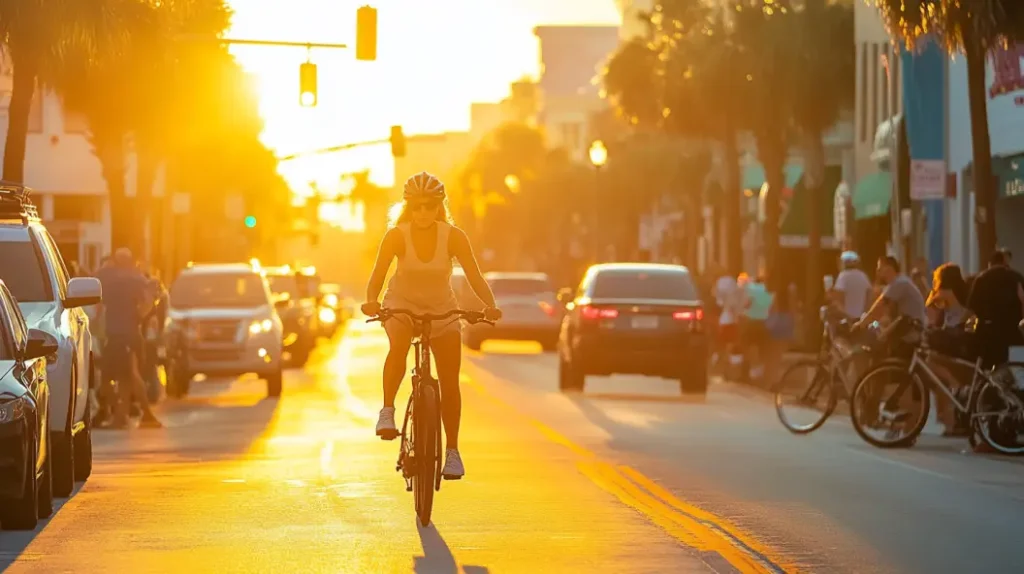
Contrary to common belief, visibility issues are not exclusive to nighttime riding; even during daylight hours, visibility challenges remain a significant factor in bicycle accidents. Research shows that more than a third of bicycle accidents occur due to low visibility factors, often surprising both cyclists and drivers. While daylight offers natural illumination, certain conditions can still obscure cyclists from a driver’s view, creating an environment where collisions are more likely to happen.
One major contributor to visibility challenges during the day is glare. Sun glare, particularly during the early morning and late afternoon hours, can temporarily blind drivers, obscuring their view of cyclists on the road. Sarasota, known for its high levels of sunshine, can experience intense sunlight at various times of the day, and when drivers face direct glare, they may struggle to see even brightly dressed cyclists. This effect is often heightened when drivers are traveling east or west, directly into the sun. Cyclists, therefore, need to be aware of these times and take precautions, like using highly reflective or neon-colored gear, to increase their visibility.
Weather conditions also play a significant role in daytime visibility challenges. Sarasota is known for its unpredictable tropical weather, and even a brief rain shower can drastically reduce visibility. Rainwater on windshields, fog, or even high humidity can create a film that limits a driver’s view of the road, especially of smaller road users like cyclists. Mist or light fog can also obscure sightlines, making it harder for drivers to see a cyclist until they are quite close, reducing the time to react safely. For cyclists, wearing bright, waterproof gear can help, but it is not always sufficient to guarantee visibility, especially under sudden or extreme weather shifts.
Obstructed sightlines are another issue contributing to daytime accidents. Trees, parked cars, and even road signs can block a driver’s view of a cyclist, especially at intersections or in areas with heavy pedestrian traffic. For example, a cyclist approaching an intersection may be hidden by a larger vehicle or shrubbery, which could prevent an oncoming driver from seeing them in time. This is especially risky in areas with multiple entry points, such as parking lots or commercial zones, where drivers are often focused on looking for other cars rather than bicycles. Cyclists need to be vigilant in these situations, but the unpredictability of sight obstructions makes avoiding all risks impossible.
Although cyclists can reduce their risk by wearing bright, reflective clothing and using visibility-enhancing accessories, these measures are not foolproof. Many cyclists involved in accidents report wearing reflective gear, only to find that factors beyond their control, like glare or blind spots, contributed to the collision. The unpredictability of these challenges underlines the importance of awareness and proactive driving from everyone on the road. While visibility challenges are a significant concern, another critical factor affecting cyclist safety is riding direction. Even when cyclists are highly visible, the choice to ride against traffic—known as wrong-way cycling—introduces a new layer of risk that can have severe consequences.
The Dangers of Wrong-Way Cycling
Riding against the flow of traffic, or wrong-way cycling, is a dangerous practice that unfortunately remains common among cyclists. This approach dramatically reduces visibility and reaction times for drivers and is one of the more hazardous choices a cyclist can make. When a cyclist rides against traffic, they essentially double the closing speed of any approaching vehicles, giving drivers less time to see them and react appropriately. For instance, if both the cyclist and driver are moving toward each other at 30 mph, they will close the gap between them at a combined speed of 60 mph, leaving very little room for evasive action.
Wrong-way cycling also creates confusion for drivers. Motorists are trained to anticipate traffic moving in one direction, and when they see a cyclist approaching in the opposite direction, it can disrupt their expectations. For example, a driver making a right turn at an intersection might look left for oncoming traffic, only to find a cyclist suddenly approaching from the right. This sudden appearance often leaves drivers with minimal time to respond, resulting in a higher likelihood of collision.
Our bicycle accident attorneys in Sarasota at Goldman, Babboni, Fernandez, Murphy & Walsh often encounter cases where wrong-way cycling contributed to a severe accident, sometimes involving high-speed impacts due to the reduced time drivers have to react. Wrong-way cycling is particularly hazardous in urban areas or on streets with limited space, where there is little room for drivers or cyclists to maneuver around each other. In these situations, even the most alert driver may be caught off guard by a cyclist riding against traffic, resulting in serious injuries for the cyclist, who is more vulnerable in a crash.
Wrong-way cycling also increases the likelihood of a head-on collision, one of the most dangerous types of accidents a cyclist can experience. Unlike side-swipe accidents, where the impact might be glancing, a head-on collision with an oncoming vehicle often results in severe injuries or fatalities for cyclists due to the direct force of the impact. In addition to avoiding dangerous practices like wrong-way cycling, understanding right of way rules is essential for creating safer roads. Right of way knowledge not only helps prevent accidents but also clarifies responsibility in the event of a collision. In Sarasota, where cycling is popular, following these rules is crucial for both cyclists and drivers to coexist safely on the road.
Right of Way Rules for Bicyclists
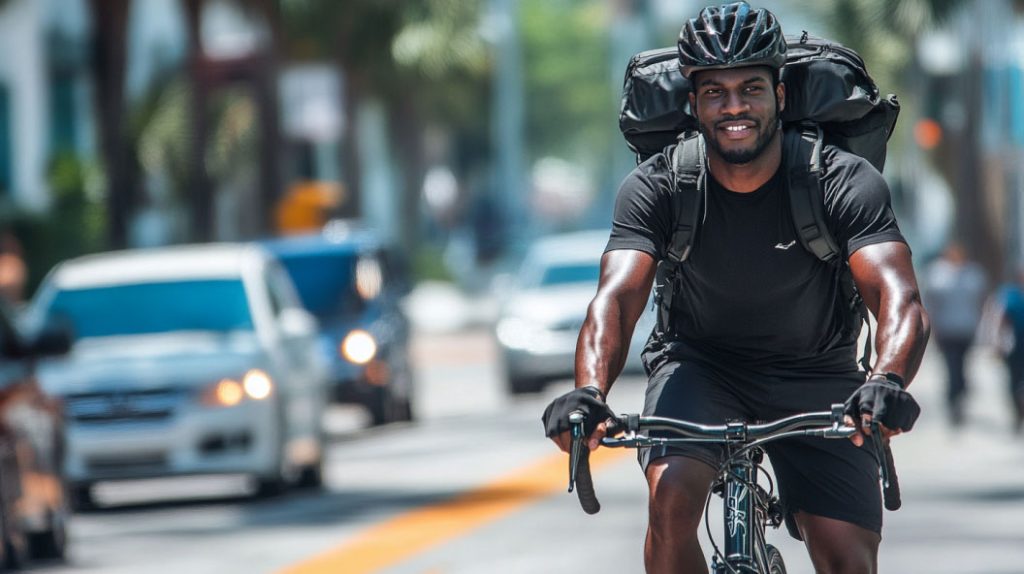
Understanding and respecting right of way rules is fundamental to creating safer roads for everyone—especially in Sarasota, where cycling is a popular mode of transportation and recreation. For both cyclists and motorists, knowing who has the right of way can prevent many dangerous situations and help clarify liability in the event of an accident. As Sarasota bicycle accident attorneys, we often see cases where misunderstandings or outright ignorance of these rules lead to collisions, injuries, and complicated legal battles. By breaking down the most essential right of way rules, cyclists and drivers alike can make better decisions on the road.
Yielding to Pedestrians: Cyclists’ Responsibilities
Cyclists, just like drivers, are required to yield the right of way to pedestrians. Pedestrians always have the highest priority on the road, especially in areas specifically designated for their safety, like crosswalks and sidewalks. When approaching a crosswalk, cyclists must slow down, stop if necessary, and allow pedestrians to cross safely. It’s important to note that this rule applies whether or not there are traffic signals or signage; the presence of a pedestrian at a crosswalk automatically means that cyclists must yield.
In some cases, a cyclist may be tempted to swerve around pedestrians or rush through a crosswalk to maintain their momentum. This can be incredibly dangerous, as it puts the cyclist in close proximity to pedestrians who may not be expecting a bike to pass so closely. Additionally, if a cyclist fails to yield to pedestrians, they may be found partially or fully at fault in the event of an accident. Adhering to this rule not only protects pedestrians but also minimizes legal complications for cyclists who may otherwise face liability if a collision occurs.
Furthermore, cyclists must give pedestrians ample space when riding on shared paths or multi-use trails. On these paths, which are common in Sarasota, cyclists need to exercise caution and be ready to stop if a pedestrian steps into their path. By being mindful and respectful of pedestrians’ right of way, cyclists can reduce the likelihood of accidents and improve safety for everyone using Sarasota’s mixed-use trails and walkways. Just as cyclists must respect pedestrians’ right of way on shared paths, motorists have a responsibility to ensure the safety of cyclists in designated bike lanes. These lanes are intended to provide a secure space for cyclists, but their effectiveness relies on drivers yielding appropriately and remaining vigilant, especially at intersections and turns.
Bike Lanes and Motorist Responsibilities
In Sarasota and throughout Florida, bike lanes are designated areas that provide a safer space for cyclists to travel. When cyclists are riding in these designated bike lanes, motorists are required to yield the right of way to them. This means that a car should never cut across a bike lane without first checking for cyclists, especially when approaching intersections, driveways, or making turns. Motorists need to be particularly vigilant when turning right across a bike lane, as cyclists traveling straight may be approaching faster than anticipated.
A common scenario that often results in accidents is when a motorist makes a right turn across a bike lane without checking for cyclists who may be in the lane. This situation, called a “right hook” accident, occurs when a driver underestimates the speed of a cyclist or fails to notice them entirely. In such cases, the driver can be held liable for failing to yield. A Sarasota bicycle accident attorney at Goldman, Babboni, Fernandez, Murphy & Walsh will often examine whether the driver observed proper right of way rules when a cyclist is struck while in a bike lane.
Motorists must also recognize that bike lanes are not parking lanes or shoulder lanes. Parking or stopping in a bike lane can force cyclists to enter traffic lanes, putting them at risk. Unfortunately, it’s not uncommon for drivers to treat bike lanes as temporary loading zones or places to wait for a passenger, which forces cyclists to negotiate around them into moving traffic. Sarasota law enforcement is increasingly focused on addressing this issue, and drivers found obstructing bike lanes may face fines. Adhering to bike lane rules and yielding to cyclists using these lanes is essential for road safety and preventing liability in case of an accident. When bike lanes are unavailable, cyclists often have no choice but to merge into regular traffic lanes, where they are granted the same rights and responsibilities as any other vehicle. In these situations, it’s essential for motorists to recognize cyclists’ equal right to the road and to adjust their behavior accordingly to ensure everyone’s safety.
Cyclists in Traffic Lanes: Equal Rights and Responsibilities
When bike lanes are unavailable, cyclists have the right to ride in regular traffic lanes, and, in these situations, they are legally considered equal to motor vehicles. This means that cyclists riding in traffic lanes have the same right of way as any car or truck on the road. Motorists are required to treat cyclists in traffic lanes as they would any other vehicle, meaning they must allow adequate space, avoid passing too closely, and refrain from aggressive driving behavior.
A significant rule that often goes overlooked is that drivers must give cyclists a minimum of three feet of clearance when passing. In Sarasota, as in other parts of Florida, this “three-foot rule” is intended to prevent accidents caused by close passing, which can be particularly dangerous for cyclists who may be unsteady on uneven road surfaces. Violating this rule can lead to fines and, in the event of an accident, can establish driver fault for failing to give cyclists the legally required amount of space. An experienced bicycle accident attorney can help enforce these protections, holding drivers accountable when they fail to respect the right of way for cyclists in traffic lanes.
Cyclists also have responsibilities when sharing traffic lanes with vehicles. For instance, they should ride as close to the right side of the road as practicable unless they are making a left turn, avoiding an obstruction, or riding on a narrow lane where it’s safer to take the full lane to discourage unsafe passing. In multi-lane roads, cyclists should signal their intentions to merge or turn, giving motorists time to adjust. Observing these practices helps cyclists stay visible to drivers, reducing the likelihood of accidents and contributing to the overall flow of traffic. While cyclists can take precautions to share the road responsibly and communicate their movements to drivers, some risks remain outside their control. Poor road conditions, like potholes and debris, can turn an otherwise safe ride into a dangerous experience. In Sarasota, where scenic routes are popular among cyclists, neglected infrastructure poses serious safety hazards that can lead to accidents and even liability for the responsible parties.
Poor Road Conditions Lead to Liability
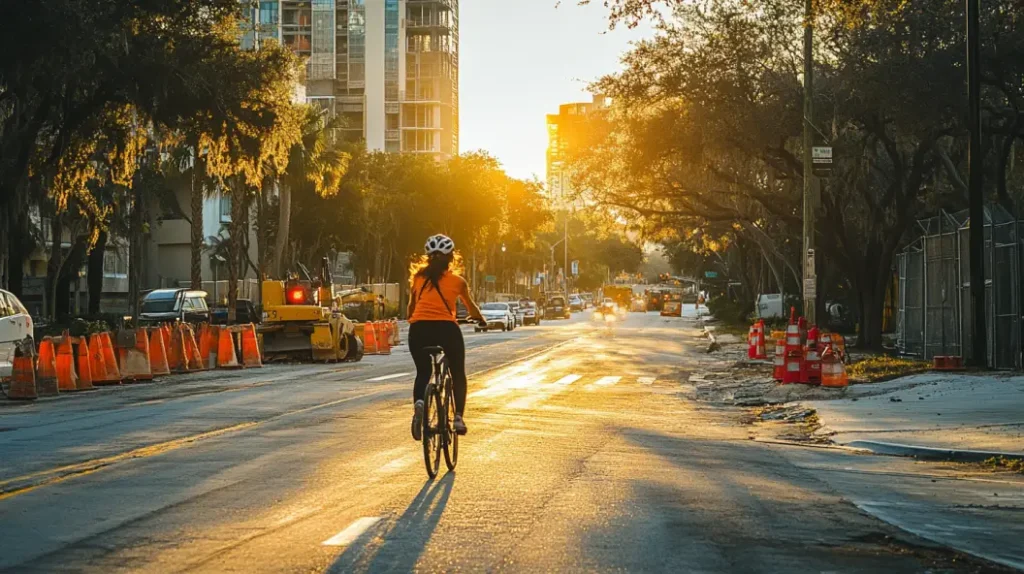
The Hidden Dangers of Neglected Infrastructure
Cycling through Sarasota’s picturesque streets, surrounded by palm trees and beautiful coastal views, it’s easy to feel a sense of freedom and safety on the road. However, beneath the surface of this serene setting, hidden dangers lurk in the form of neglected infrastructure. Poor road conditions—such as potholes, cracked pavement, debris, and uneven surfaces—pose significant risks to cyclists, who are far more vulnerable to road hazards than motorists. When infrastructure fails to meet safe standards, a simple ride can quickly turn treacherous, with cyclists facing the risk of serious injury from unexpected road hazards.
For cyclists, encountering poorly maintained roads can be particularly hazardous. Potholes, for instance, are a common but often overlooked threat. Even a small pothole can cause a bicycle tire to become lodged or a cyclist to lose balance, potentially leading to a fall or collision with nearby vehicles. Uneven surfaces, like cracked asphalt or poorly patched roadways, can destabilize a bike’s wheels, especially at higher speeds or when turning. Cyclists must handle these hazards carefully, but the unpredictability of road conditions makes avoiding every risk impossible.
Debris, like loose gravel, broken glass, or litter, is another issue that poses severe risks. While motorists can usually drive over small debris without consequence, a cyclist hitting a piece of glass or loose rock can experience a sudden puncture or loss of control. This issue is particularly common in areas with high foot traffic, where litter and broken materials may accumulate. Cyclists may also encounter construction debris in Sarasota, where road improvement projects or repairs may inadvertently leave materials on the roadway. Although these situations may seem minor, the impact can be catastrophic for cyclists, who are more likely to suffer serious injuries in a fall or collision caused by road debris.
Beyond immediate physical risks, neglected infrastructure creates significant legal complexities for cyclists injured in accidents caused by poor road conditions. Unlike typical vehicle accidents, where liability is often clear-cut, bicycle accidents involving road hazards can involve multiple parties, including city or county governments, construction companies, and contractors responsible for maintenance. Sarasota’s government and other agencies are responsible for maintaining safe roadways, but proving that neglected infrastructure caused a specific accident can be challenging. In such cases, understanding your legal options and seeking assistance from a Sarasota bicycle accident attorney can be essential.
Seeking Justice for Negligent Maintenance
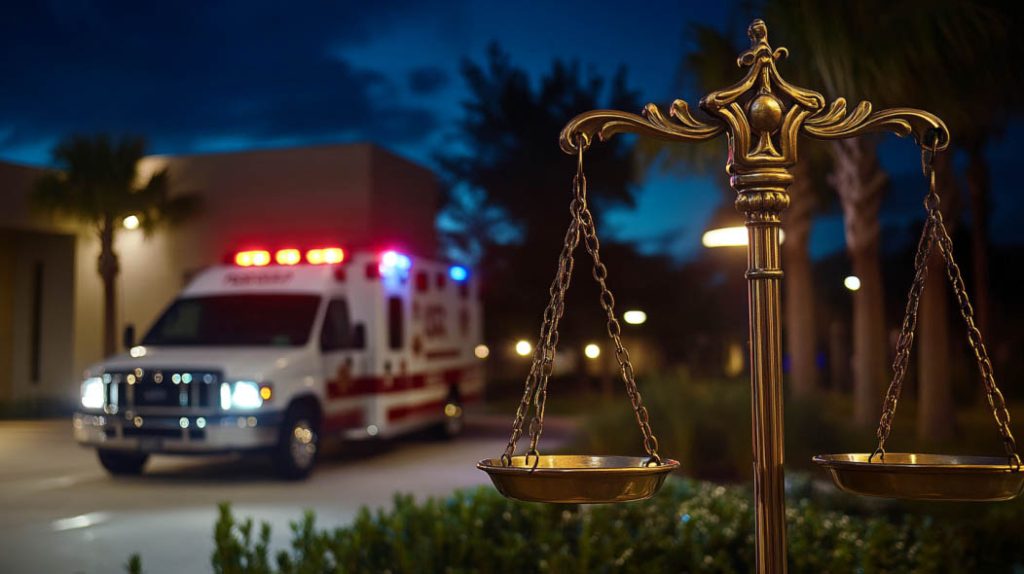
If you’ve been injured in a bicycle accident due to poor road conditions, you may have grounds for a legal claim. Pursuing compensation for an accident involving neglected infrastructure requires a thorough understanding of liability. A Sarasota bicycle accident attorney at Goldman, Babboni, Fernandez, Murphy & Walsh can help you investigate the conditions leading up to the accident, determining who was responsible for road maintenance and whether they failed to uphold their duty to provide a safe roadway.
To build a successful case, an attorney will work to gather evidence that proves the poor road conditions directly contributed to the accident. This can include photographs of the hazardous road conditions, eyewitness statements, and documentation of previous complaints or repair requests regarding the specific stretch of road. In some cases, traffic or security camera footage may show the hazardous road condition and how it impacted the cyclist. Experienced attorneys are skilled at collecting this evidence, connecting it to the injury, and building a strong case that highlights the negligence of the responsible parties.
Additionally, a knowledgeable bicycle accident attorney understands the importance of establishing a clear link between the condition of the road and the injuries sustained. This might involve consulting with accident reconstruction experts who can testify to the role that specific hazards, like potholes or loose gravel, played in causing the cyclist’s fall or crash. Proving this connection can be complex, especially when dealing with government entities that often have strict procedural requirements for liability claims. Sarasota cyclists who suffer injuries due to poor road conditions should not hesitate to seek legal guidance, as attorneys can effectively handle these intricacies and maximize the chances of obtaining fair compensation.
The Importance of Prompt Action
Acting quickly is crucial when dealing with bicycle accidents caused by neglected infrastructure, as critical evidence may disappear over time. For instance, a city may repair a pothole shortly after an accident, erasing evidence of the hazardous condition. Loose debris may be swept away by street cleaners, or new pavement markings may cover uneven surfaces, making it difficult to prove the presence of these hazards at the time of the accident. Taking photographs immediately after the accident or obtaining witness statements can preserve this evidence, but a legal team can ensure all necessary documentation is gathered and safeguarded promptly.
Time is also essential due to the strict deadlines for filing claims against government entities. In Florida, filing an injury claim against a government agency typically involves a shorter statute of limitations and a formal notice requirement, which can be challenging to navigate without legal experience. Government agencies must be notified in writing within a specified timeframe—often 180 days from the date of the accident—detailing the claim and evidence. Missing this deadline can prevent you from pursuing compensation, regardless of the severity of your injuries or the degree of the government’s negligence.
By consulting with a Sarasota bicycle accident attorney soon after the accident, you ensure that these procedural requirements are met and that your rights are protected. An attorney can help gather all relevant documentation, contact appropriate witnesses, and ensure that the government entity is notified in compliance with state laws. Working with a legal professional also provides peace of mind, allowing you to focus on recovery while your attorney handles the complexities of the case.
Holding government entities and other parties accountable for unsafe infrastructure is not only a means to secure compensation but also a vital step toward making Sarasota’s roads safer for all cyclists. When cyclists pursue justice for injuries caused by poor road conditions, they send a message to municipalities that proper road maintenance is essential. Accountability may lead to more frequent inspections, quicker repairs, and safer infrastructure, ultimately reducing the likelihood of similar accidents in the future.
Protecting Your Safety and Rights on Sarasota’s Roads
Understanding the hidden dangers of neglected infrastructure is essential for Sarasota cyclists who want to ride safely and avoid unexpected hazards. Poorly maintained roads, debris, and uneven surfaces can turn a leisurely ride into a life-threatening situation in an instant. While cyclists can take certain precautions—such as remaining vigilant on unfamiliar routes, using wider tires that handle rougher terrain, and avoiding routes known for poor maintenance—the responsibility ultimately lies with government agencies and contractors to provide safe, well-maintained roadways.
If you or someone you know has been injured in a bicycle accident due to neglected road conditions, know that you have the right to pursue justice. Seeking assistance from an experienced Sarasota bicycle accident attorney ensures that you have a knowledgeable advocate who understands the legal landscape of infrastructure-related claims. By acting swiftly and working with a skilled attorney, you protect your rights, increase the chances of fair compensation, and contribute to improving road safety for all cyclists in the community.
Driver Inattention And Bicycle Accidents In Sarasota
Driver inattention is a leading cause of bicycle accidents in Sarasota and across the country. As a bicycle accident attorney, we often see cases where a moment of driver distraction leads to devastating consequences for cyclists.
Forms of Driver Inattention
Driver inattention can take many forms, including:
• Texting or using a smartphone
• Adjusting the radio or GPS
• Eating or drinking while driving
• Conversing with passengers
• Daydreaming or being lost in thought
These distractions, even if brief, can cause a driver to miss critical visual cues, such as a cyclist in their blind spot or approaching an intersection.
Unsafe Turning and Cyclist Safety
One of the most common scenarios involving driver inattention is unsafe turning. A distracted driver may fail to check for cyclists before making a turn, leading to collisions at intersections or driveways. This type of negligence often results in serious injuries for the cyclist.
Legal Implications
From a legal standpoint, driver inattention is a form of negligence. If you’ve been injured in a bicycle accident due to a distracted driver, a Sarasota bicycle accident attorney can help establish liability and seek compensation for your injuries. Remember, drivers have a duty of care to remain attentive and watch for all road users, including cyclists.
By staying vigilant and prioritizing attention on the road, drivers can significantly reduce the risk of bicycle accidents and create a safer environment for all.
When to Call a Sarasota Bicycle Accident Attorney
Immediate Action is Crucial
After a bicycle accident, time is of the essence. Contacting a Sarasota bicycle accident attorney as soon as possible can significantly strengthen your chances of securing fair compensation. The sooner you reach out to a legal professional, the better positioned you’ll be to protect your rights and interests.
Why Prompt Legal Representation Matters
Contacting our bicycle accident attorney’s at Goldman, Babboni, Fernandez, Murphy & Walsh immediately after a crash is highly recommended, especially in cases involving serious injuries. Here’s why:
Evidence preservation: An attorney can help gather and protect crucial evidence before it disappears or degrades.
Witness statements: Fresh memories often yield more accurate accounts, which your lawyer can collect promptly.
Insurance company tactics: Early legal representation can prevent you from falling victim to unfair settlement offers or manipulative tactics.
Maximizing Your Compensation
By promptly hiring a Sarasota bicycle accident attorney, you increase your chances of obtaining the compensation you deserve. Your lawyer can:
• Accurately assess the full extent of your damages, including future medical expenses and lost wages.
• Negotiate complex legal procedures and deadlines on your behalf.
• Negotiate skillfully with insurance companies and opposing counsel.
Remember, the path to fair compensation often begins with a timely call to an experienced bicycle accident attorney. Don’t delay in seeking the legal support you need to protect your rights and secure your future.
As you deal with a bicycle accident liability in Sarasota, remember that visibility, right of way, and road conditions play crucial role in determining fault. Factors such as proper lighting, clear road markings, and driver attentiveness can significantly impact the outcome of your case. Additionally, poorly maintained roads or obstructed bike lanes may shift liability to municipal agencies or other responsible parties. By understanding these essential factors, you can better protect your rights and interests in the event of a bicycle accident. The experienced attorneys at Goldman, Babboni, Fernandez, Murphy & Walsh are here to guide you through the legal process and help you secure the compensation you deserve.
More About Bike Accidents And Liability
Visibility-related characteristics of crashes involving …
Pedestrian & Bicyclist Visibility – Vision & Everyday Function
Bicycle Safety: Bike Safety Tips for Kids and Adults
The post Bike Crash In Sarasota? Essential Factors in Determining Liability for Bicycle Accidents appeared first on Justice Pays.




